These comforting soy sauce noodles come together in minutes with simple ingredients that satisfy any time of day!
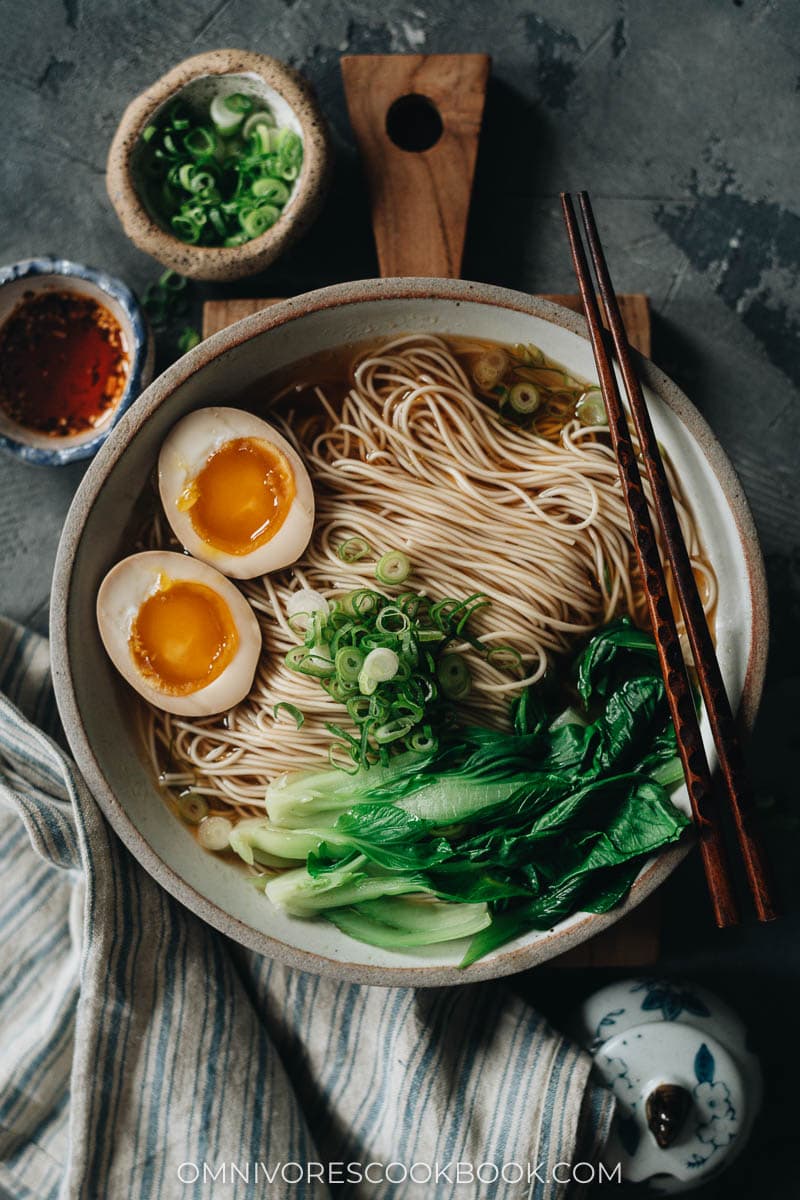
Soy sauce noodles, or yang chun mian (杨春面) as they are called in Chinese, are a typical breakfast dish. Though I would eat them at any time of day. They’re popular because they’re so quick and easy to make, plus they just happen to be addictively delicious with a few simple ingredients.
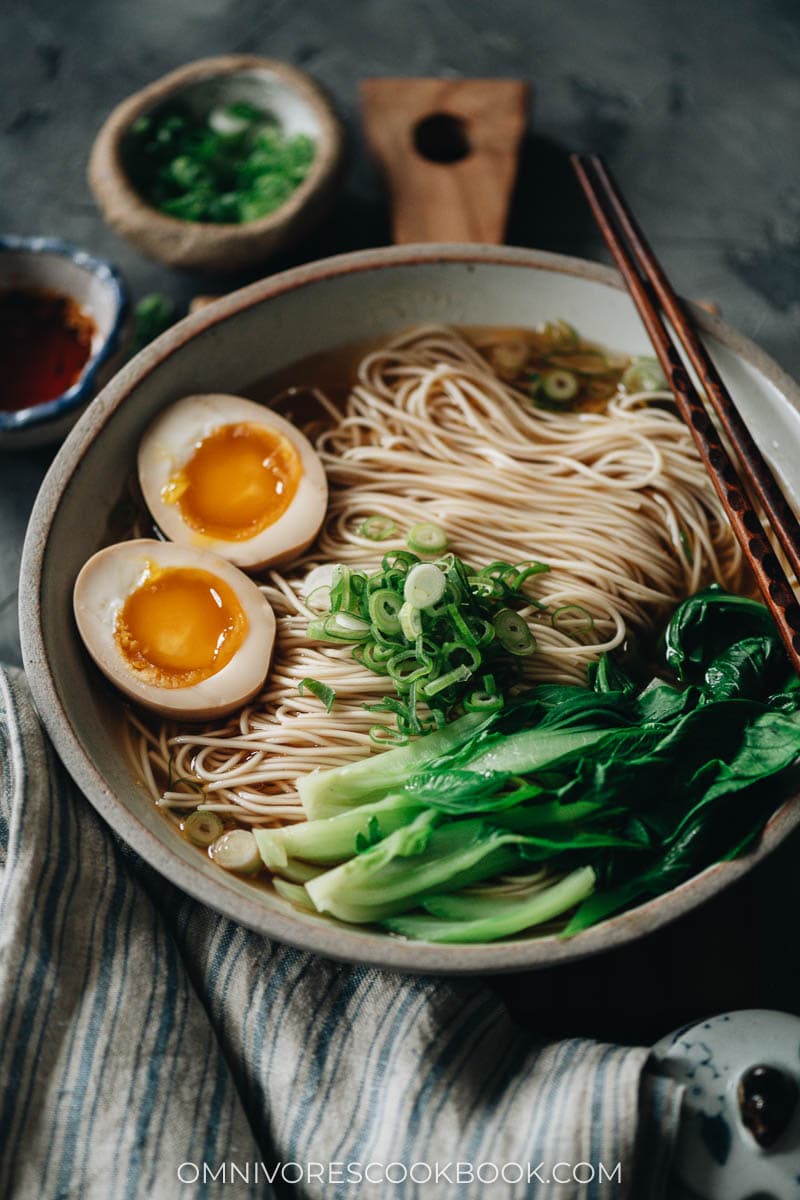
Why this recipe
I’ve shared a recipe for soy sauce noodles before but I came up with a more simplified version of this famous minimalistic noodle dish that uses pantry ingredients so you can have it on your table in just 10 minutes.
So, why am I updating my soy sauce noodles recipe? My old recipe called for making a homemade chicken stock. I wanted to make this even easier by using store-bought stock which you can still get great flavor from.
In the traditional version, lard is often used for flavor. But these soy sauce noodles call for extra sesame oil and chicken bouillon powder to boost the flavor so you don’t have to worry about lard.
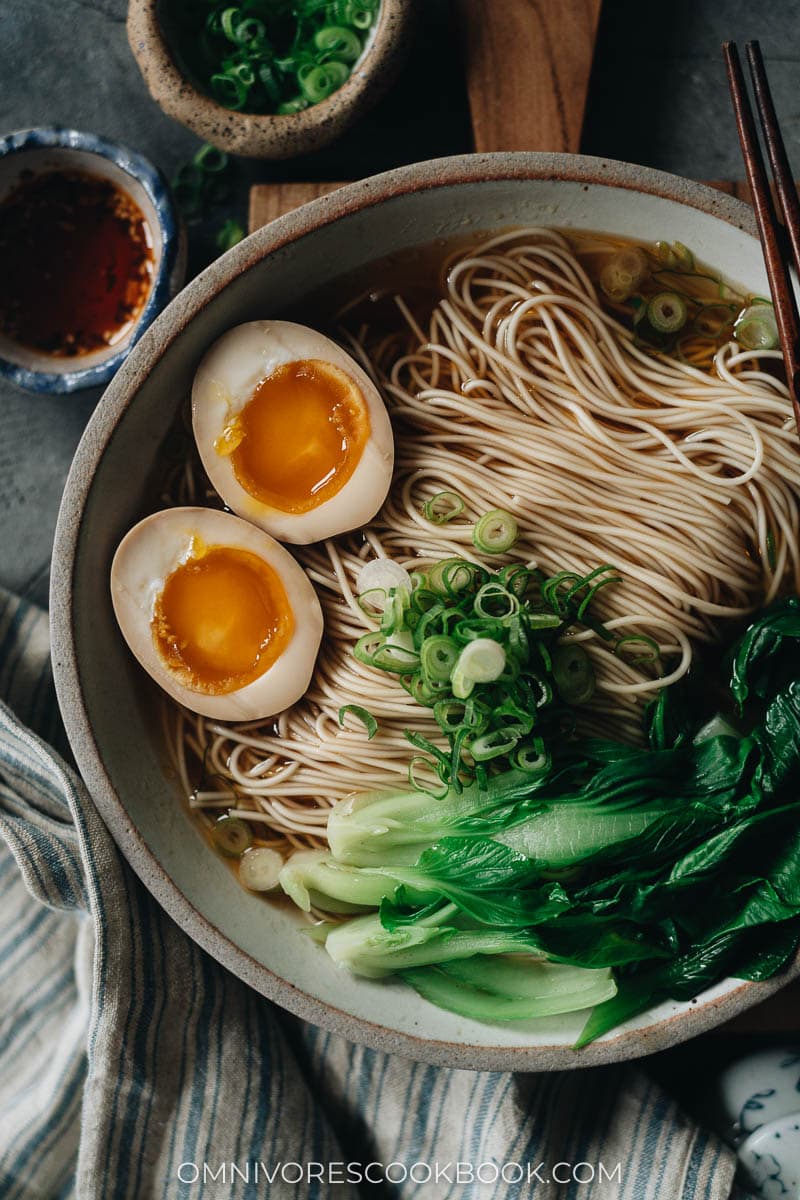
One word on MSG
To make the dish more similar to the authentic Chinese version, you can use MSG instead of chicken bouillon. I realize many people are concerned about MSG. Chinese restaurants in the US have adapted to this concern by doing without this simple ingredient and often advertise that they don’t use it. However, it’s simply a sodium salt from glutamic acid and is all natural. A lot of foods such as cheese, meat, and seaweed contain it. It adds a great umami flavor, and, contrary to popular belief, the FDA says it is safe to eat and has not been demonstrated to cause side effects.
While it is very common in Asian cooking, I personally keep it to a minimum and rely on other ingredients to bring out the flavors. However, I will add a pinch of MSG to a simple veggie stir-fry because it elevates the taste so well. It’s up to you if you want to use it, which is why I have chicken bouillon powder listed in the recipe for you instead.
What type of noodles to use
I always prefer to use the thin wheat noodles because they absorb more flavor from the broth and are suitable for this simple dish. In China, we call them Gua Mian (挂面), or Long Xu Mian (龙须面, Dragon whisker noodles), which are a bit thinner than Gua Mian. Both come in dried form and are easy to find in an Asian market. If you shop at a Japanese market or a regular grocery store, you may find Somen, which is the same type of noodles used in Japanese cooking.
Note, the Chinese and Japanese noodles are the same in nature, but they can come in very differently sized bundles. You can make one serving using one Japanese bundle, but probably half of a Chinese bundle, which is bigger.

If you’re feeling fancy, you can also use the thin noodles from my hand pulled noodle recipe.
Noodle Toppings
Traditionally, yang chun mian doesn’t have any toppings. All you would do is boil the noodles in chicken stock, add some soy sauce, and it would be done.
I like adding green onions to the top, as well as bok choy, though you can add any green veggies you like. I think blanched spinach or kale would also be wonderful on these soy sauce noodles.
In addition to adding some greens on top of this, I highly recommend topping these noodles with my easy soy sauce eggs. For something so simple, you won’t believe how delicious it tastes!
And of course, if you want to make the meal more filling, you can also throw some rotisserie chicken or leftover meat on top.
These soy sauce noodles are so easy to make so I’m skipping the cooking process photos this time. It’s great for a snack or as a simple meal!
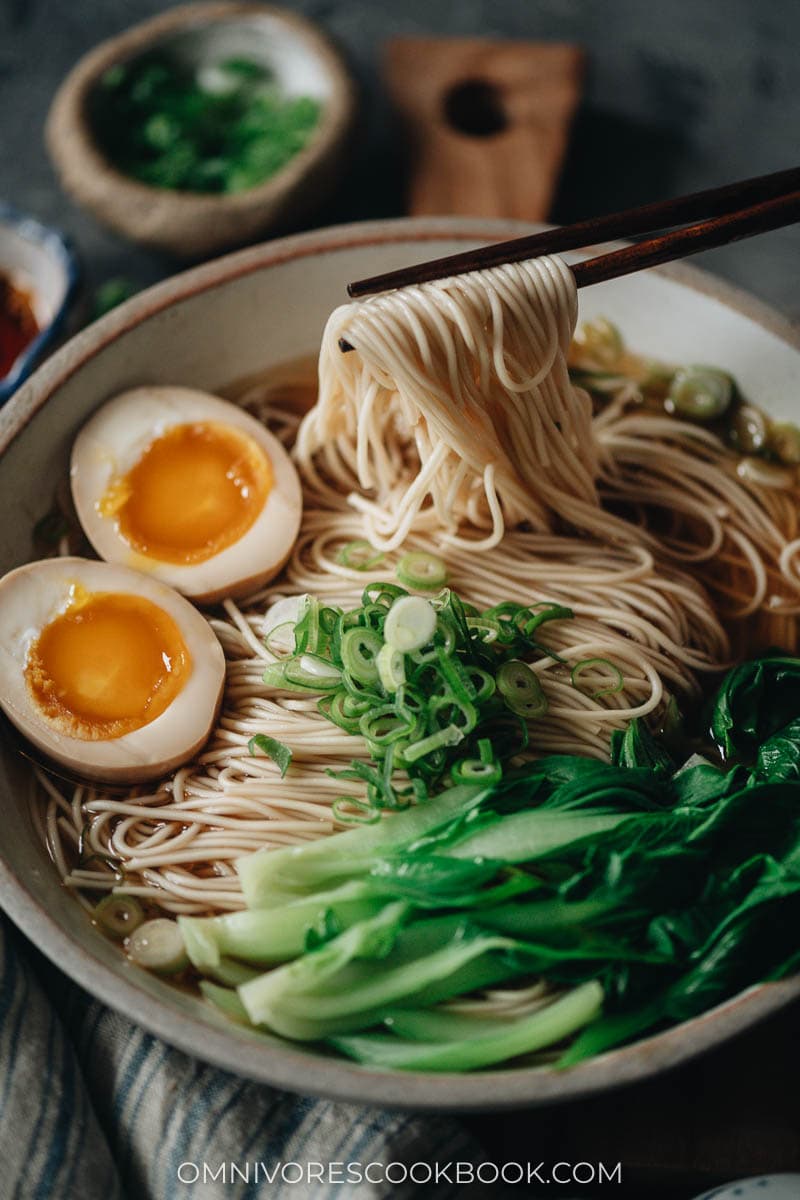
Want to learn more about Chinese Cooking? Sign up my newsletter to receive the 5-Day Chinese Cooking Crash Course and recipe update!

Soy Sauce Noodles (阳春面)
Ingredients
- 1 green onion , sliced
- 1/2 teaspoon sugar
- 1/2 teaspoon chicken bouillon powder (or 1/4 teaspoon MSG)
- 2 teaspoons sesame oil
- 2 teaspoons light soy sauce , or to taste
- 2 cups chicken stock
- 110 g (4 oz) dried thin wheat noodles or somen noodles , or 200 g (7 oz) fresh noodles or thin hand-pulled noodles
Topping options
- 2 baby bok choy quartered (or vegetable of your choice)
- Homemade soy sauce egg
- Homemade chili oil *Footnote 1
Instructions
- If making two small bowls, divide the green onions evenly between two bowls and add 1/4 teaspoon sugar, 1/4 teaspoon chicken bouillon powder, 1 teaspoon sesame oil, and 1 or 2 teaspoons soy sauce to each bowl (depending on preference and the saltiness of the stock used). Add everything to a big bowl if making 1 serving.
- Bring a pot of water to a boil. At the same time bring the chicken stock to a boil and add 1 cup to each bowl. Stir to dissolve the sugar and chicken bouillon powder.
- If adding bok choy or another vegetable blanch them in the boiling water until just cooked through, between 30 seconds to 1 minute, until just cooked through. Distribute the bok choy evenly between the bowls (or if you would like to lay them on top for looks, set them aside and place them on after the noodles are added).
- Boil the noodles according to the instructions on the package, try to get them al dente so they don’t overcook in the broth, usually 1 minute less than indicated on the package.
- Drain the noodles and rinse briefly under cold water to stop the cooking. Add half to each bowl.
- Taste and add more sesame oil or soy sauce if needed. Top with other ingredients if using.
Notes
- Taste the soup first before spicing it up. You might find you don’t actually need the chili oil 🙂
Nutrition
If you give this recipe a try, let us know! Leave a comment, rate it (once you’ve tried it), and take a picture and tag it @omnivorescookbook on Instagram! I’d love to see what you come up with.
More delicious noodle recipes
- Hot Dry Noodles (热干面)
- Cumin Lamb Noodles
- Easy Hand-Pulled Noodles
- Beef Pan-Fried Noodles
- Yaka Mein (Beef Noodle Soup)
Lilja Walter is a part of the Omnivore’s Cookbook team and worked closely with Maggie to develop and test this recipe.













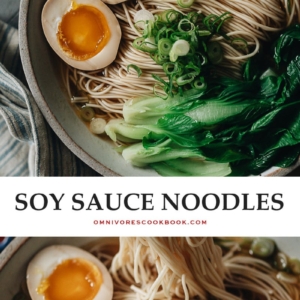
Oh my word, that runny egg! I just want to turn up this whole bowl and slurp it down!
Every time I see this pic I get hungry, Maggie. I love these flavors and this dish is so mouth-watering. I don’t eat eggs nearly as much as I should and this is an easy way to add them to my diet.
Your photos are simple perfection!
What kind of noodles are you using? I need to know! This looks so good!
Thanks! I used Japanese somen. I think ramen noodles or other thin types will work well too.
Thanks! This looks delicious!
Hey, that looks great, I must try them!!! 😉
Somehow I stumbled across your recipe and it looks so yummy! We have a Chinese exchange student who eats noodles almost every day. He’ll be surprised when I make this for him, thanks!
Hi Cindy, yep noodles is a big thing in China and some people eat it from breakfast to dinner. Hope the cooking went well and your student enjoyed it 🙂
When you say 1.5 to 2 cups of stock is it diluted in water? If so how much?
Hi Cath, the 1.5 to 2 cups stock is the total amount of broth for the noodles. If you use the supermarket stock, I won’t dilute it, since they are not as flavorful as homemade stock. For homemade stock, you need to dilute according to your taste. For example, I usually boil down my homemade stock for easy storage, so I usually use 1 cup stock and 1 cup water. If your stock wasn’t reduced at first place, then no need to dilute it. Hope my answer isn’t too confusing!
Happy cooking and let me know how the noodles turn out 🙂
Thank you for this recipe. I am a total dud when it comes to cooking – I hate it! – yet here I am enjoying a bowl of this soup complete with runny egg. Simple and delicious!
Hi there – can’t wait to make this for lunch tomorrow! Will definitely warm me up in the cold Dunedin weather. I was wondering whether you poached your egg in your stock, or boiled it? Would either be OK?
Cheers!
Hi Michaela, I’m glad to hear you’d like to try out this recipe! I always poach the egg in the stock because it’s faster and easier. Either way will work! Happy cooking and let me know how the noodles turn out 🙂
Hi Maggie,
This recipe looks soooooo good! I bought Udon and Soba noodles from the store few days ago but now I have hard time finding a great recipe for them 🙁
Would using either one for this recipe be a good idea? Thanks! 🙂
I love noodles but I didn’t have any authentic oriental recipes, so I’m delighted to discover this website. It’s going straight into my bookmarked favourites.
What kind of noodles are used please? Looks SO delicious and easy , I’m excited to make this for my grandson and me.
The thin type of noodle will work great, for example, Chinese and Korean thin dried wheat noodles made without eggs and Japanese somen (very thin). Happy cooking!
Cilantro is a mainstay of Mexican cooking, too. I also like tu choy tips,and prefer the milder Shanghai bok choy to the dwarf variety. I also like yu choy tips abd Li Sun Taiwan cabbage better than the often bitter western green cabbage. I dont care what the FDA says. My wife is violently allergic to excess anounts of MSG. It raises the blood pressure of those that are sensitive. I have seen my wife turn beet red, become short of breath after ingesting it in a resteraunt that initiially denied using it but then conceded hat it was still used in the soup that she had consumed. The reaction s well documented in medical journals. It is common in western prepared foods but not in the quanities that some Chinese resteraunts used to use. I remenber seeing a giant barrel from Accent brand MSG being used as a garbage can by a Chinese resteraunt. In moderation few are affected
Hey Maggie, we made this recipe with the salt and pepper pork chop recipe. Really enjoyed these noodles, such a delicious, moreish recipe. I now want to try this with eggs as pictured. We added back choi as suggested. What else would you suggest it could go with which maybe quite light? Thanks again, great recipe.
Hi Sashi, I’m glad to hear you like the recipe! For other veggie alternatives, I really love napa cabbage. You can also use collard greens or bean sprouts. For other meat toppings, I would add leftover rotisserie chicken or leftover roast meat, but the runny eggs are always my favorite!
Ridiculously easy and ridiculously delicious. I’ve also made this an extremely lazy way with pre-cooked pasta + leftover veg and microwaving the broth — not really “cooking,” but still amazing in a pinch when I’m craving something savory and comforting.
Made this recipe many times over now. It’s a perfect quick lunch and so versatile.
Great recipe. I used some left over spaghetti noodles, added several slices of BBQ pork and a tbl, of Spicy Chili Crisp. Definitely a keeper recipe.